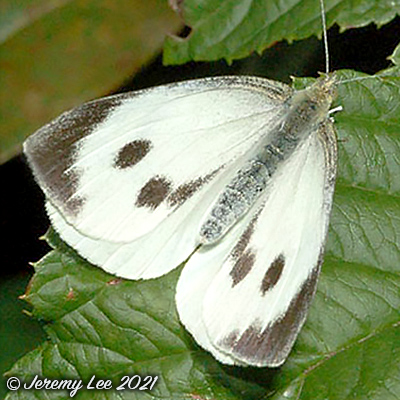
 |
|
Scientific Classifications explained » Amphibians » Ants » Aphids » Bees » Beetles » Birds » Bugs » Butterflies » Caterpillars » Damselflies » Dragonflies » Earwigs » Flies » Frog/Leafhoppers » Fungi » Galls » Grasshoppers » Harvestmen » Hoverflies » Lacewings » Ladybirds » Leaf Mines » Lichens » Mammals » Millipedes » Mosses » Moths » Sawflies » Slugs » Snails » Spiders » Trees & Shrubs » Wasps » Wild Flowers » Woodlice » Postboxes |
UK Nature > Butterflies > Pieris brassicae

Scientific Name: Pieris brassicae Common Name: Large White Pieris brassicae, more commonly known as the Large White, has a wingspan measuring 5.3 - 6.5cm. The forewing has a black tip, and, in the female, two further black spots; wing undersides have a yellowish tinge. Found throughout the UK; prefers open areas, and closely associated with agriculture due to its liking of various brassica as food plants. Also very common in parks, gardens, meadows and fields. Mating flight is spiralling and vivacious; copulating pairs often remain joined for quite a long time. Female lays golden-yellow eggs in batches close together on the underside of leaves of the chosen food plants. The caterpillars are yellowish green with black spots of various sizes and yellow lines on the top and sides. Feeds mainly on many cabbage species (hence the other popular name of Cabbage White), but also on Nasturtium, Hedge-Mustard and other plants, which can be reduced to a skeleton by the caterpillars' activities. The young caterpillars remain together at first, but disperse later. |
|

https://www.uknature.co.uk is a website dedicated to showing the immense diversity of UK nature and wildlife. Our vast range of habitats, from lowland arable to snow covered mountains, from storm-ravaged coastlines to peaceful inland freshwater lakes and rivers, from dry, sandy heaths to deciduous and coniferous forests, all these habitats contribute to the abundance of UK nature. We have wild birds in huge numbers either residing or visiting our shores (597 recorded species as at July 2013) and we must also not forget the humble back garden with its grass lawns, flower beds filled with nectar rich flowers, shrubs and trees, all designed to attract huge numbers of insects such as bees, moths, butterflies and hoverflies; and finally the small ponds which provide safe havens for frogs, toads, newts and even slow worms and grass snakes. www.uknature.co.uk is the showcase for my personal passion, photographing uknature in all its glory. I sincerely hope you all enjoy the fruits of my labours. This site and all images contained therein is © Jeremy Lee 2004 - 2025. All Rights Reserved. Site design by Jeremy Lee. Site development & IT Support by Stuart Lee. |